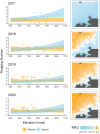Temporal and spatial variation in reproductive benefits in a partial migrant
- PMID: 39456125
- PMCID: PMC11610666
- DOI: 10.1002/ecy.4451
Temporal and spatial variation in reproductive benefits in a partial migrant
Abstract
In partial migrant systems, where residents and migrants coexist within a population, residents are commonly predicted to gain a reproductive advantage over migrants through priority access to high-quality territories and an earlier breeding start. Annual variation in reproductive benefits has been suggested to be important for the coexistence of both strategies in a population, as differences in wintering conditions experienced by the two strategies may result in a periodic reproductive advantage for migrants. However, the importance of spatial environmental variation for reproductive output in partially migrant populations remains largely unexplored. We investigated variation in the reproductive output of migrants and residents in a population of Swiss red kites (Milvus milvus) both temporally, across and within years, and spatially, along an elevational gradient. We gathered 4 years of reproductive data combined with 183 GPS-derived full annual cycles from individuals breeding in the Swiss Alpine foothills. At low, but not high, elevations, residents produced more fledglings than migrants. We also found evidence for annual variation in the reproductive advantage of the two strategies. Furthermore, while reproductive output did decline with a later breeding start, there was no difference in the start of breeding between the two migration strategies. The results of this study suggest that differences in reproductive output between migrants and residents in partial migrant populations can vary both due to the use of spatially distinct overwintering grounds and because the strategies are differently affected by spatial variables in the breeding area, such as elevation. The study emphasizes that spatial and temporal variation in reproductive benefits must be considered when predicting how migratory species will respond to future environmental change.
Keywords: Milvus milvus; competition; elevational gradient; fledgling number; migration strategy; red kite; relative reproductive output.
© 2024 The Author(s). Ecology published by Wiley Periodicals LLC on behalf of The Ecological Society of America.
Conflict of interest statement
The authors declare no conflicts of interest.
Figures




References
-
- Aebischer, A. , Perrin N., Krieg M., Studer J., and Meyer D. R.. 1996. “The Role of Territory Choice, Mate Choice and Arrival Date on Breeding Success in the Savi's Warbler Locustella luscinioides .” Journal of Avian Biology 27(2): 143–152. 10.2307/3677143. - DOI
-
- Aebischer, A. , and Scherler P.. 2021. Der Rotmilan – Ein Greifvogel Im Aufwind, 1st ed. Berne: Haupt Verlag.
-
- Badyaev, A. V. 1997. “Avian Life History Variation along Altitudinal Gradients: An Example with Cardueline Finches.” Oecologia 111: 365–374. - PubMed
MeSH terms
Grants and funding
LinkOut - more resources
Full Text Sources
